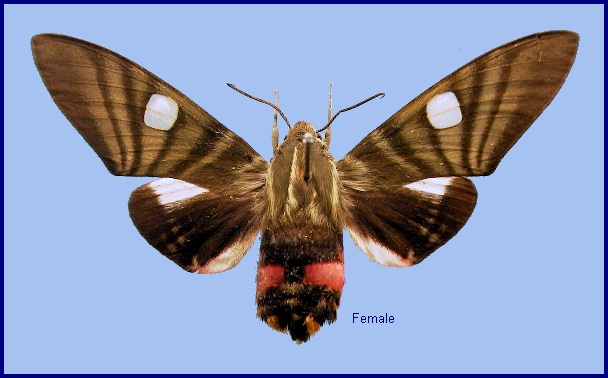
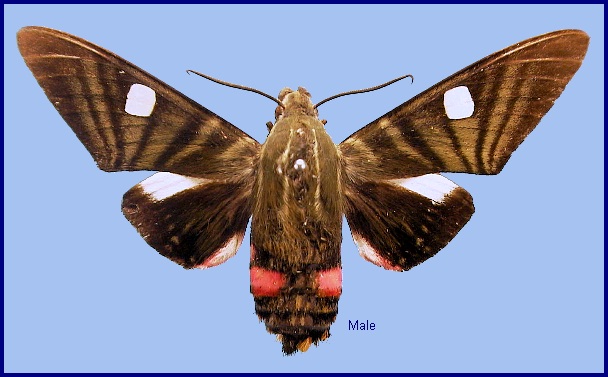
Macroglossa triopus Westwood, 1847, Cabinet oriental Ent.: [14], pl. 6, fig. 4. Type locality: [India,] Assam.
Synonym. Macroglossa triopus Westwood, 1847.
Wingspan: 64--78mm. An unmistakable species. Forewing upperside dark grey-green (fading to greyish-brown) with six narrow transverse blackish bands; discal spot large, rectangular and translucent. Hindwing upperside black with conspicuous white costal patch and tornal area. Hindwing underside reddish orange (as abdomen underside). Metanotum dark brown with creamy white stripes. Abdomen upperside black with an interrupted belt red and lateral orange spots. Underside of thorax and abdomen reddish-orange.
In the male genitalia, uncus and gnathos forming a typical macroglossine 'bird-beak' structure. Uncus almost straight, sparsely hairy dorsally. Gnathos slightly curved, slender than uncus, with tiny apical hook. Valva rounded, with terminal part wider than basal part, apex blunt. Sacculus long and thicker, markedly curved upward apically into a harpe. Phallus long and straight, with transverse process distally; two diverticula of everted vesica forming a 'bird-beak' type structure, ending into slender hook with smooth surface (Jiang, Xu, Cheng, Li & Hu, 2023).
In the female genitalia, anal papillae apophyses blunt. Lamella antevaginalis sclerotized; lamella postvaginalis narrow, sharp, with arrow-like central part; ostial lobe elongate and narrowed. Ductus bursae tubular and membranous, rather thick. Corpus bursae oblong, signum present as a slender sclerotized patch (Jiang, Xu, Cheng, Li & Hu, 2023).
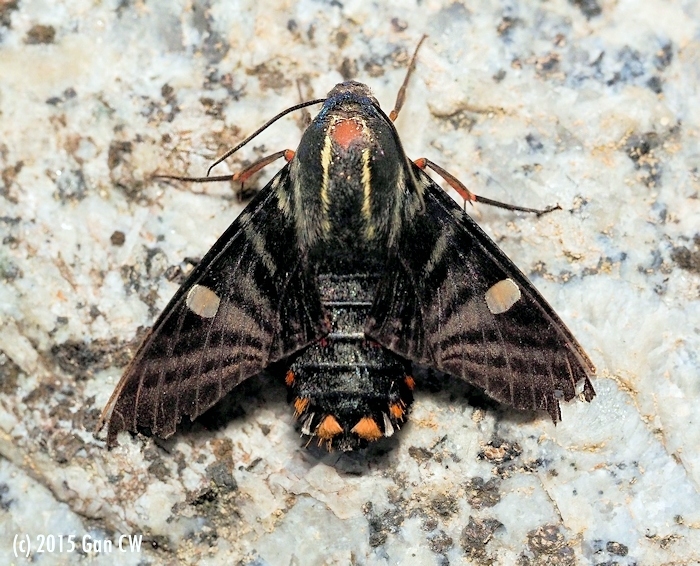
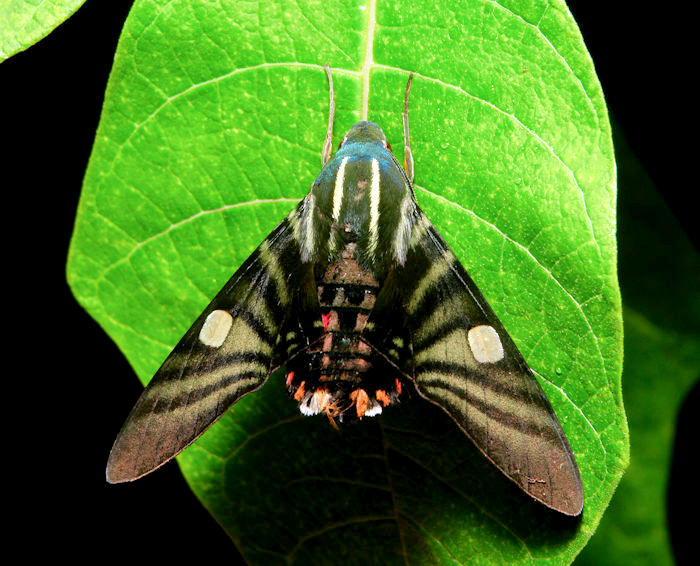
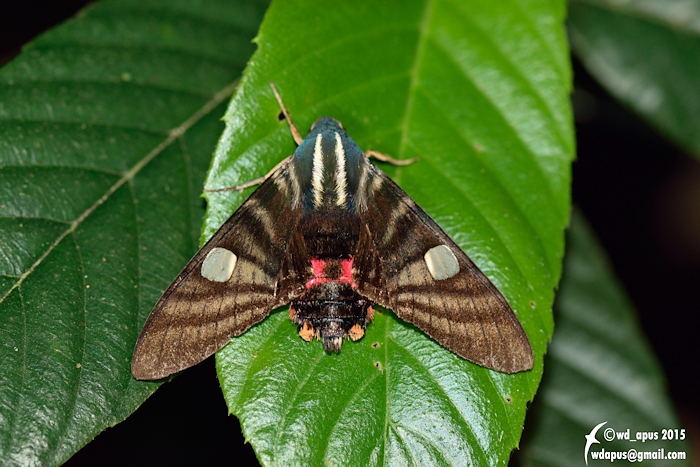
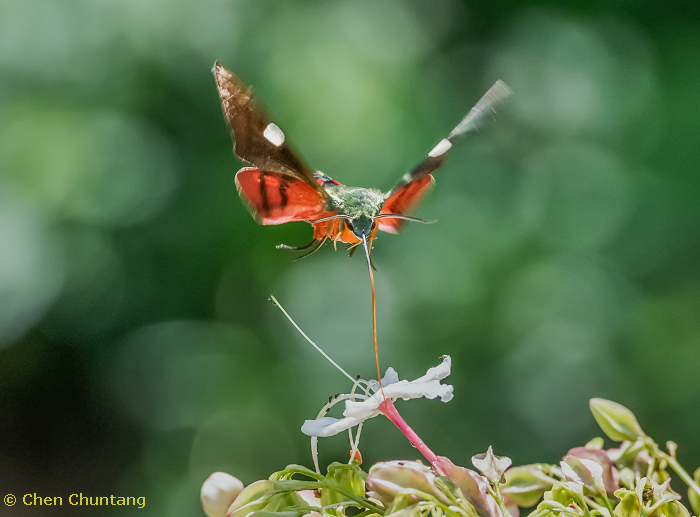
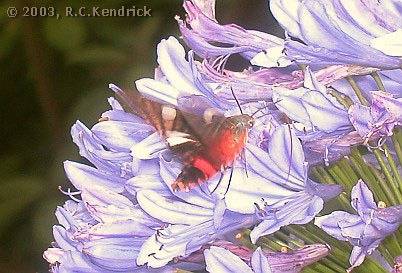
A diurnal species with a fast but bumbling flight -- has difficulty pinpointing flowers. Attracted to the blossom of Agapanthus africanus and Pavetta hongkongensis in Hong Kong. Will fly during damp, overcast conditions and in hot, sunny weather, generally during the the late morning and early afternoon (R. Kendrick, pers. comm. 2000). The resting position is the same as for those of the genus Macroglossum (Bell & Scott, 1937).
In Yunnan, Guizhou, Fujian and Hainan, it was found flying rapidly during the day in broad-leaved evergreen forest among riparian vegetation, or visiting flowers, especially when it was hot and sunny (Jiang, Xu, Cheng, Li & Hu, 2023).
China: iv (Xishuangbanna, Yunnan; Hainan); v (Fujian); vi (Guangdong; Hong Kong); 5.viii (Zhejiang; Guizhou); 10-12.viii (Simao/Pu'er, Yunnan; Hainan); ix (Hong Kong).
Early May in Nepal at 1600m altitude.
OVUM: Broadly ovoid; surface smooth and shiny; colour pale grass-green; size larger than those of Macroglossum and Cephonodes (Bell & Scott, 1937).
LARVA: Full-fed 70mm, width 11mm, horn 14mm. Dichromatic, with both green and red forms (Li Li, pers. comm. 2023). According to Bell & Scott (1937), in the final instar head round, surface smooth. Body tapering sharply frontad from segment 5; horn long, stout, laterally compressed, ending in a sharp point, basal half gently upcurved, distal half gently down-curved. Surface of body dull and smooth except for four small tubercles on the front half of each of segments 6 to 11, on the dorso-lateral stripe, those on 7 and 8 larger than the rest. Horn with tubercles on dorsal and ventral surface.
In the green form, head green, with a white stripe separating face from cheek. Body pale green, the divisions between the secondary rings white. There is an indistinct dark green dorsal stripe and a white dorso-lateral stripe, the latter clearly defined on 2 to 4, faint on 5 to 11, and with white tubercles on 6 to 11, edged above with dark green on these segments. There are bluish-white oblique lateral stripes, which are clearest on 7 to 9. Horn bluish-green with a small, triangular, bluish latero-basal patch, the tubercles green. True legs pale flesh-colour, outer faces red; shanks of prolegs dull terracotta. Spiracles pure white with a broad transverse brick-red band across the middle of all except those on segments 11 and 12, which are immaculate white and twice as large as the rest (Bell & Scott, 1937).
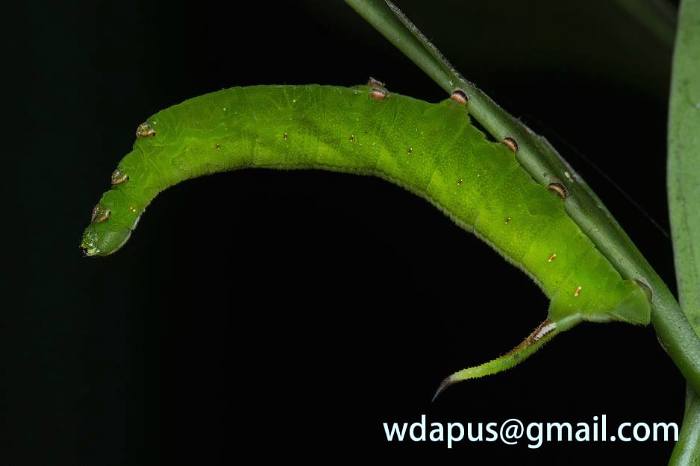
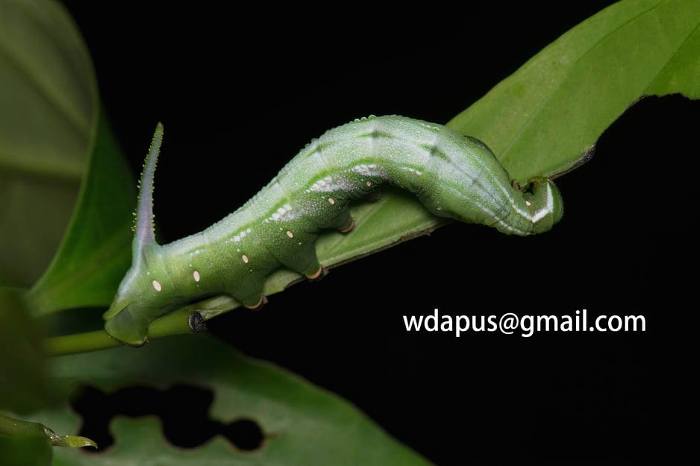
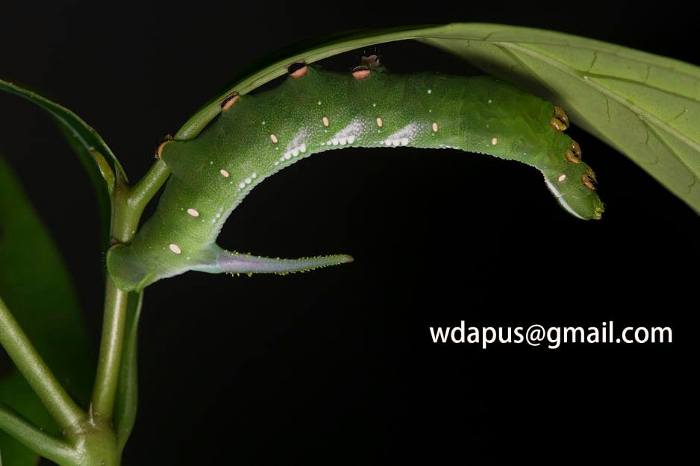
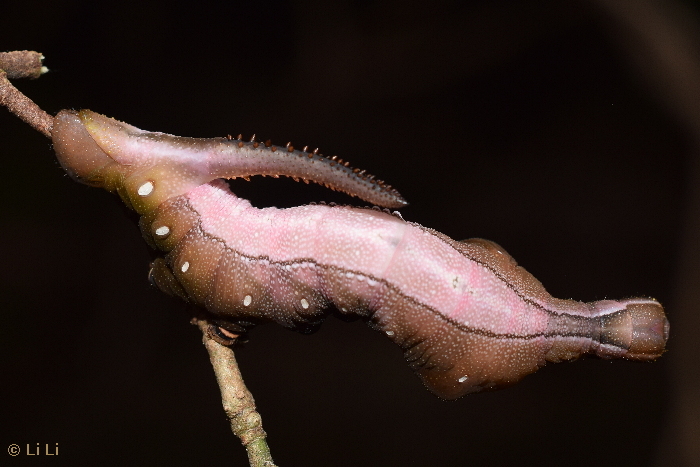
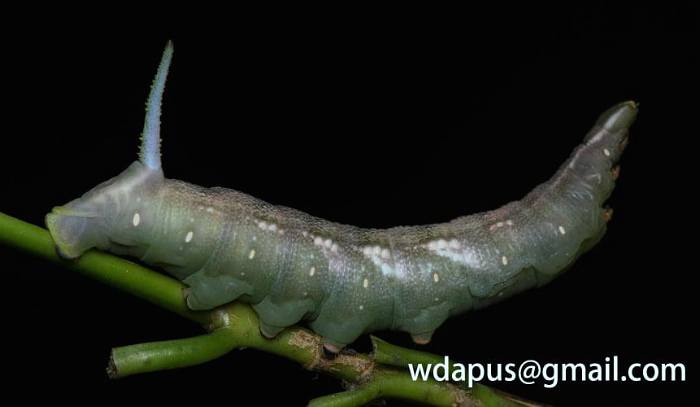
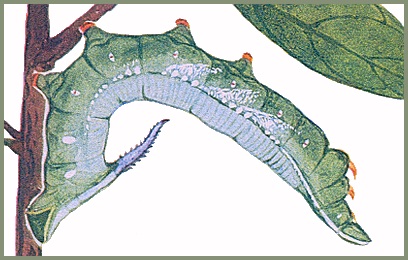
PUPA: 42--52mm, breadth 11--14mm. Very like that of Cizara sculpta in shape. In colour, tongue greyish-green, darker at tip; thorax and wing-case greyish-green; two pale chestnut spots on segment 2. Legs dark chestnut barred with pale orange, abdomen pale ochreous-brown above, reddish-brown with short longitudinal chestnut lines below; bevels of free abdominal segments dark chestnut. There are broad blackish patches and short black lines between the spiracles of segments 3 to 10. Tongue-case projecting slightly beyond the frons; antenna equal to fore leg, coxal piece absent or rudimentary. Surface smooth and shiny. Cremaster conical, tapering gently to a short, widely bifid tip (Bell & Scott, 1937).
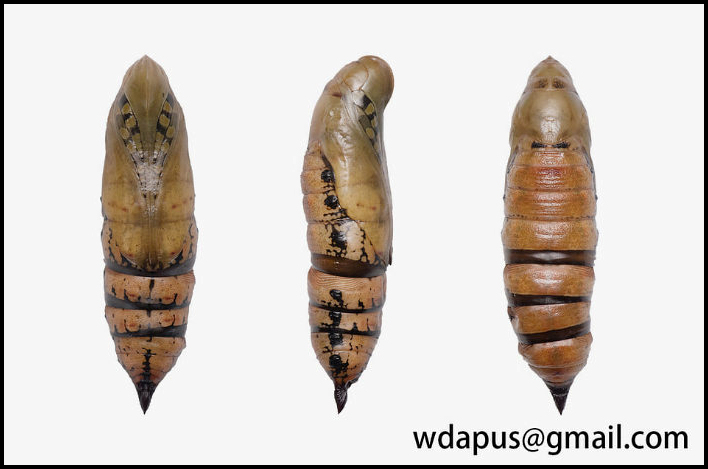
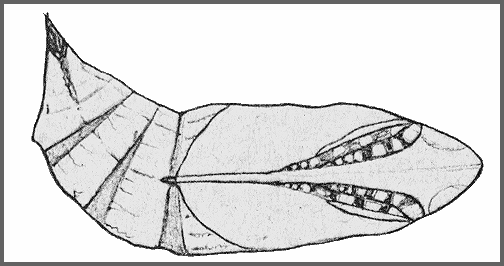
Larval hostplants. On Chinese Buttonbush (Adina pilulifera (Lam.) Franch. ex Drake [syn. Adina globiflora Salisb.]) (Rubiaceae) in India (Bell & Scott, 1937) and Guangdong (ZhenBang Xu, pers. comm. 2024). On Aidia canthioides (Champ. ex Benth.) Masam. in Yunnan (WangDa Cheng, pers. comm. 2021) and Hong Kong (Jiang, Xu, Cheng, Li & Hu, 2023), as well as Benkara sinensis (Lour.) Ridsdale in Yunnan (Jiang, Xu, Cheng, Li & Hu, 2023).
Unknown.
China: Zhejiang (Kuocang Mountain Nature Reserve; Taishun, Wenzhou; Quzhou; Dayuantou); Yunnan (Simao/Pu'er; Xishuangbanna, 950m); Guizhou (Libo County, 680m); Jiangxi (Ji'an); Fujian (Youxi County, 530m; Ruiyun Shan; Panyang, nr Fuzhou); Guangdong (Longtou Shan; Dongguan; Shenzhen; Guangzhou); Hong Kong (Kadoorie Farm and Botanic Garden; Victoria Peak); Guangxi (Longmen); Hainan (Tonza; Mt. Jiangfengling, Ledong County, 760m).
Nepal (Lamjung), Bhutan (Irungbam & Irungbam, 2019), northeastern India (West Bengal, Arunachal Pradesh (Mishmi Hills), Uttarakhand), southern China, Myanmar/Burma, Thailand, Laos, and northern and central Vietnam. Also recorded from Fraser's Hill, Peninsular Malaysia (CheongWeei Gan, pers. obs. 2015)
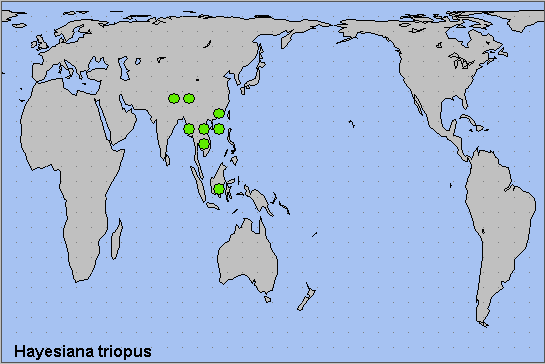
 Return to Sphingidae of the Eastern Palaearctic species list
Return to Sphingidae of the Eastern Palaearctic species list